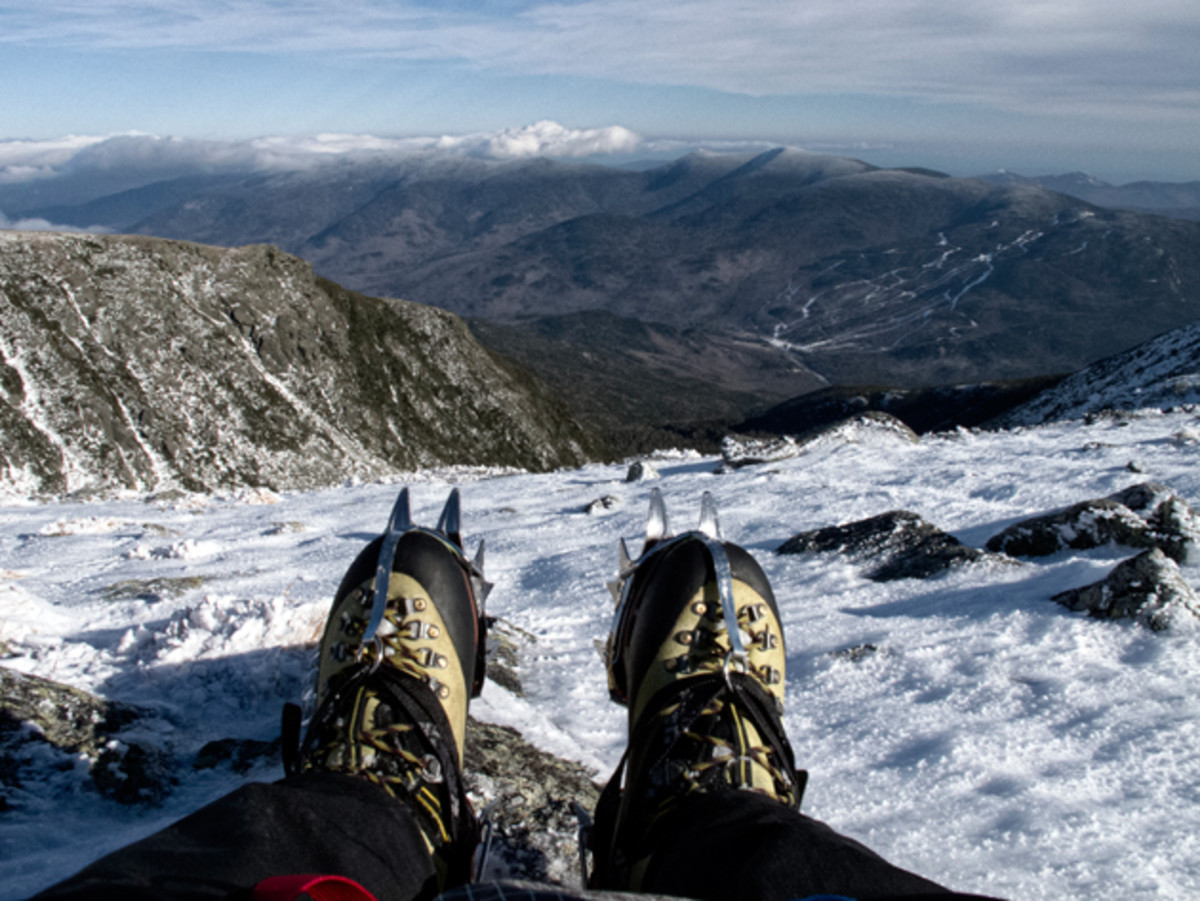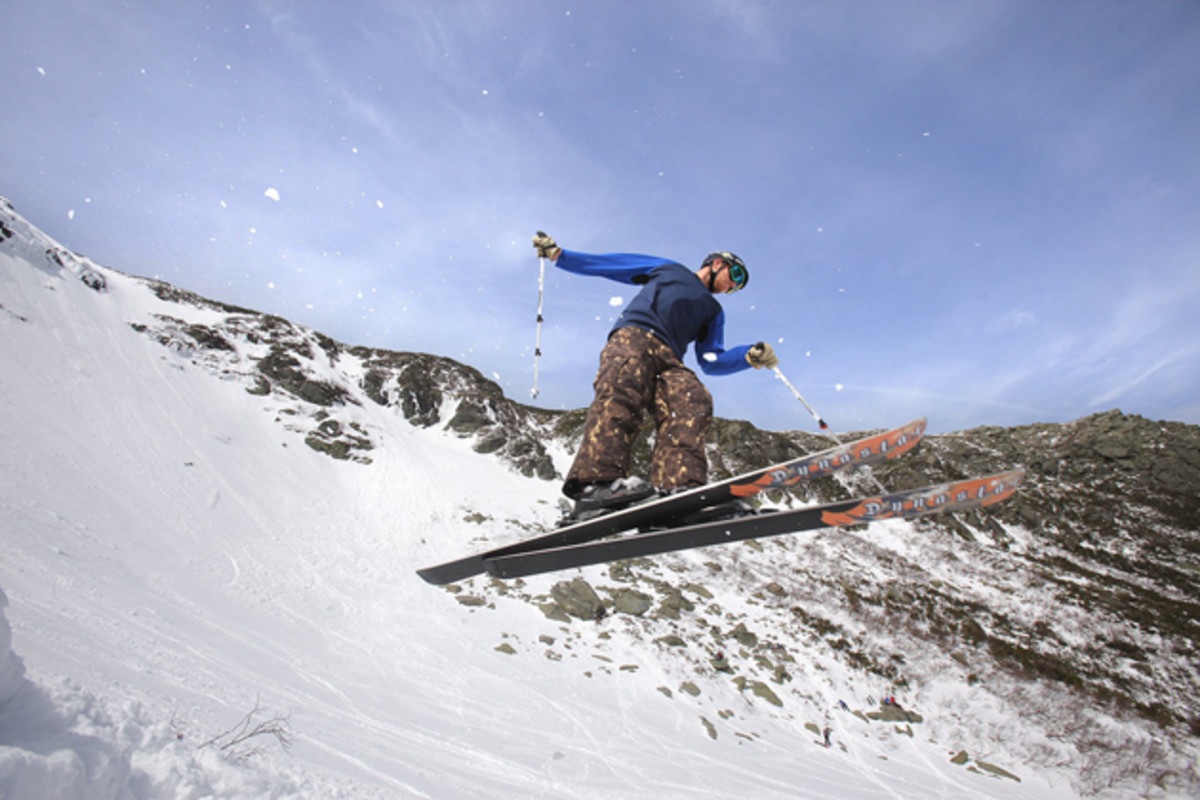Birth of Extreme Skiing: The thrill and terror at Tuckerman Ravine

It’s difficult to imagine exactly what was going through Anton (Toni) Matt’s mind one spring day in 1939—April 16, to be precise—as he veered toward the edge of the gaping granite maw known as Tuckerman Ravine on the southeastern flank of New Hampshire’s Mount Washington.
The 19-year-old Austrian, who had come to the U.S. just five months earlier to teach at Hannes Schneider’s ski school at Cranmore Mountain Resort, was the third competitor in the third running of the American Inferno race. He launched into the 4.2-mile course from the summit of the 6,288-foot peak, where winds were gusting at 60 mph, and visibility was sketchy at best.
“Going over the lip is a terrifying experience, especially for the first time,” Matt (who died in 1989 at age 69) told Skiing magazine’s Bruce Sherman in 1964. “Remember, I had schussed from the very top of the mountain, which is at least a thousand feet higher than the lip, and then made only one turn into the headwall.
“I was coming into the sudden drop-off at 40, 45 miles an hour. That’s not at all like coming in from a dead standstill. It’s more like jumping into a 600-foot deep hole from a speeding car.”
Matt soared over the lip, and pointed his skis directly downhill, hitting an estimated top speed in excess of 80 mph.
Lance Armstrong in exile is restless, feisty and . . . underappreciated?
“I had figured on making at least two or three turns while going over the lip, which, even at slow speeds, feels like going down an elevator shaft,” he told Sherman. “When I got to the top of the headwall I was moving much faster than I had expected. I knew the lip was fast and treacherous, and if I made a false move I would take a terrible fall. I figured it would be safer actually to run straight than to turn. So on the spur of the moment, I decided to go all out—to schuss the headwall.”
Matt’s audacious line was as “extreme” as any ripped by modern-day daredevils Scot Schmidt, Glen Plake, or the late Shane McConkey. He completed the Inferno in 6 minutes and 29 seconds, nearly a full minute faster than the second-place finisher, Olympian Dick Durrance.
“Toni Matt’s run on the Headwall is still the talk of skiers whenever racing is discussed,” wrote Joe Dodge in the March 1951 issue of Ski magazine. “He took the Headwall practically straight, with hardly a check at the lip of the Ravine. Everyone could hear his skis chatter on the ice on the floor of the Ravine before he shot over the Little Headwall and down onto the Sherburne Trail.”
After his mind-boggling schuss, Matt shrugged off the performance, saying he was fortunate to be “nineteen, stupid, and have strong legs.” Dodge, a Mount Washington legend in his own right, predicted in 1951 that more Infernos would be held, but the race never returned.
Skiers and snowboarders, however, make the trek back to “Tucks” every year.

“I think most extreme skiers find themselves in Matt’s boots eventually, just to a smaller degree,” says Peter Tamposi, 48, a New Hampshire lawyer and longtime Tuckerman addict. “Word is Matt didn’t exactly plan his epic run, but he brilliantly improvised on the fly and let them ride. That’s the hallmark of extreme skiing—try to make it look like you planned it that way, and keep smiling.”
That, of course, is part of the draw.
“Anyone skiing over the lip has to have thought about what that must feel like to straight-line over and just keep going, especially on 1939 gear,” says Bruce Hurley, a ski patroller from Wildcat Mountain, which looks out at Tuckerman from across Pinkham Notch. “I’ve always assumed he didn’t know what was in front of him, and once the bottom dropped out, it was just time to tuck and go. That takes some super-human cojones.”
***
Oddly enough, Tuckerman Ravine, best known for its abundant snowpack, is actually named for a dedicated scientist who made his name studying all things green. Edward Tuckerman was a botanist who studied alpine flora in the early 1800s.
“The ravine is basically a sheer rock cliff,” says Lafe Low, a self-describe “Raviniac” from Massachusetts. “It’s worth seeing the ravine in the summer. It will make you wonder how anyone ever thought it would be a good idea to ski up there. But it is. It’s a great idea.”
According to New England Ski Museum director Jeffrey Leich, the first person to ski on Mount Washington was a Dr. Wiskott from Germany, in 1899. The first person to ski Tuckerman is believed to be John S. Apperson of New York, an accomplished climber, skier, and environmentalist from the Adirondack Mountains who visited the ravine in April 1914. Apperson’s foray was the start of something big.
Top of the World: Chamonix boasts unrivaled terrain, culture and danger
Today, this massive glacial cirque, at 4,430 feet above sea level and roughly 800 feet of sheer vertical, is an awe-inspiring place, the Holy Grail of New England spring skiing. Starting in March, and picking up momentum through April, Tuckerman sings its siren song to hundreds, if not thousands, of adventure enthusiasts looking to extend their ski season. Thrill-seekers bring skis, poles, boots, snowboards, food, flasks, even the occasional keg of beer to the ravine floor and Lunch Rocks before tackling the last uphill grunt to Tuckerman’s lip.
“Tucks has an amazing pitch, and offers a wide variety of lines,” says Chris Gibson, a New Jersey native now living near Boston. “But in the end it really is just a day of hiking with a massive three-minute adrenaline rush.”
Skiing any of the 10 major routes that line Tuckerman’s major bowl and the seven routes along neighboring Hillman’s Highway—many featuring pitches between 40 and 55 degrees—can be a heart-pounding experience.
“Spring skiers in the bowl generally talk of the soft ‘corn’ snow, but the conditions vary wildly and change every hour,” says Hurley. “It helps to think about that before you pick your route. I’d been in the bowl many times before as a hiker, and it's always breathtaking, like a half-empty stadium looming in front of you.”
Folks simply don’t forget their first date with Tuck’s.
“My initial impression was ‘Wow, this place is steep,’” says Tamposi, who first skied the ravine almost three decades ago, as a college freshman. “I considered myself an expert skier and capable of running anything in the East. Then I found myself standing on an 18-inch ledge carved out of a seemingly vertical wall and trying like hell to get my skis on.
“I wasn't sure if the shaking in my legs was fatigue from the three-hour hike getting there, or from fear.”
***
In an area that doesn't suffer fools or mistakes—more than 100 hikers and skiers have met untimely ends on Mount Washington—Tuckerman Ravine can be ruthlessly unforgiving. To be blunt, it can be a terrible, forbidding place for the uninitiated and unprepared.
Every year, U.S. Forest Service rangers and volunteers respond to dozens of search-and-rescue incidents resulting from poor planning, improper skills and equipment, or bad judgment. Tamposi recalls one outing when one sad-sack snowboarder discovered he was no match for the mountain.
“He shot out of the Left Gully like it was a cannon, doing the most epic rag-doll tumble you can imagine, with helmet, gloves and pack all flying off him,” says Tamposi. “By the time he came sliding by me, just below the gulley, he was unconscious, and obviously had two broken ankles.

“I stopped him and summoned the patrollers, who belayed him down and carried him out,” he said. “The gulley was solid ice and we decided after seeing that to chill out on Lunch Rocks, and forget the skis.”
Much like hikers who need to be cognizant of incoming inclement weather, skiers and snowboarders need to be keenly aware of ravine conditions. Avalanches are a very real and ever-present danger.
“The climb is unnerving, exposed; you can’t mess up,” says Tamposi. “Generally the mountain won’t tolerate mistakes. It’s that last bit, the closeness of the edge, that keeps me going back.”
Clearly, the sublime combination of terror and exhilaration is as intoxicating today as it was the day of Matt’s mad dash.
“I have the Bradford Washburn print of Tuckerman Ravine hanging in my office, right in front of me at eye-level. It sort of keeps me sane on crazy days,” says Low. “Funny that the prospect of hauling 60 pounds of ski gear to the roof of New England, then skiing a 50-degree rock-lined chute sort of keeps me sane—sort of.
“I have been to the ravine nearly every spring since college,” says Low, who graduated in 1984. “To call it a rite of passage seems trite; it’s more like a religious experience.”
